#source: Global Sanctuary for Elephant
Text
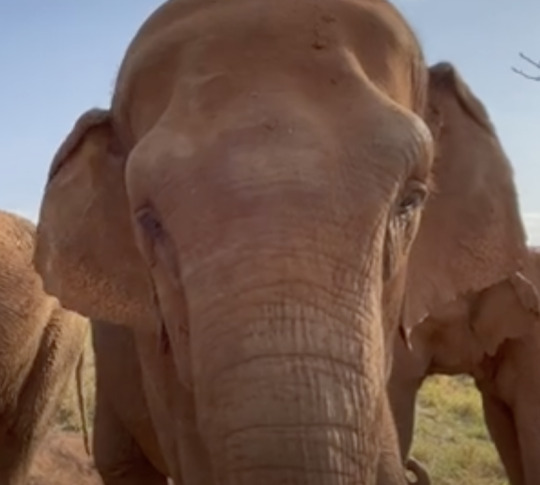
Day 222 of posting pictures of elephants.
#helLO#cute animals#cuteness#elephant#adorable#image of the day#not my image#wildlife#cuteness overload#elephants#nature#source: Global Sanctuary for Elephant#s
34 notes
·
View notes
Photo

TOMORROW, MAY 7! Friends in D.C, I hope you'll join me at the Kennedy Center in Washington, D.C. at the @FinancialTimes Weekend Festival. There will be a host of illustrious writers and thinkers — including Chimamanda Ngozi Adichi — as part of the day-long event. A handful of both in-person and virtual tickets are still available. Get yours at the link in my profile. In this photo, keeper Jerison Lengonyekie feeds an orphaned baby elephant at Reteti Elephant Sanctuary (@r.e.s.c.u.e) in northern Kenya. The sanctuary turned a pandemic challenge into a win—for the calves, the community, and the land. For years, baby elephants lived off powdered milk formula, the same used for infant humans. But when global supply chains were severely disrupted by the pandemic, the sanctuary had to find a more dependable source of food for its calves, who had been either orphaned or abandoned. Fortunately, the answer was right in their backyard. The sanctuary experimented using local goat's milk instead of the expensive formula shipped from far away. After studying the formula and extensive research, they put the new formula to the test and fed the baby elephants the goat’s milk. Reteti's elephant keepers quickly noticed that the young elephants were getting healthier. It also brought about a shift in the relationships between the community members and the calves. Not only is it more nutritious for the elephants, it is also more sustainable for the planet and it is empowering the women in the community who are benefitting from this new source of income. Learn more, including how to help by following @r.e.s.c.u.e and @sararafoundation @ft_weekend @kenyawildlifeservice @nikonusa #nikonnofilter #nikonlove #nikonambassador #kenya #africa #conservation #elephants https://www.instagram.com/p/CdODXVlMVi4/?igshid=NGJjMDIxMWI=
3 notes
·
View notes
Text
India: A Tapestry of Culture, History, and Diversity
India, the land of vibrant colors, rich traditions, and diverse landscapes, is a country that captivates the soul. Nestled in South Asia, India is not just a nation but a tapestry of culture, history, and diversity that has fascinated people from around the world for centuries.
Cultural Kaleidoscope:
India's cultural heritage is a melange of ancient traditions and contemporary influences. With a history dating back thousands of years, India has been the cradle of major religions like Hinduism, Buddhism, Jainism, and Sikhism. The diversity of religious beliefs has given rise to a harmonious coexistence of temples, mosques, churches, and gurdwaras, making India a symbol of religious pluralism.
Indian festivals, celebrated with zeal and enthusiasm, are a testament to this cultural tapestry. Diwali, the Festival of Lights, celebrates the victory of light over darkness. Holi, the Festival of Colors, symbolizes the triumph of good over evil. Eid, Christmas, and Guru Nanak Jayanti are celebrated with equal fervor, fostering unity among different communities.
Historical Landmarks:
India's history is etched in its monumental architecture. The country boasts an array of historical landmarks that tell tales of empires, dynasties, and revolutions. The Taj Mahal, a UNESCO World Heritage Site, is a testament to Mughal architecture and an enduring symbol of love. The ancient city of Varanasi, with its ghats along the Ganges River, is a spiritual hub dating back over 2,500 years.
The influence of British colonialism can be seen in the grandeur of New Delhi, where historic monuments like India Gate and the Parliament House stand alongside modern structures. The ruins of Hampi, the rock-cut temples of Ellora and Ajanta, and the forts of Rajasthan all narrate India's captivating history.
Diverse Geography:
India's geography is as varied as its culture. From the towering Himalayan peaks in the north to the lush backwaters of Kerala in the south, India offers a diverse natural landscape. The Thar Desert in the west, the fertile plains of the Ganges River, and the dense jungles of the Western Ghats provide a unique geographical experience.
India's wildlife is equally diverse, with national parks and sanctuaries home to majestic animals like tigers, elephants, and rhinoceroses. The Sundarbans mangrove forest is famous for its royal Bengal tigers, while the Rann of Kutch is a vast salt marsh that transforms into a white desert during the dry season.
Culinary Delights:
Indian cuisine is a sensory delight that mirrors the country's diversity. Each region offers a distinct palate of flavors, spices, and cooking techniques. From the fiery curries of the south to the delectable kebabs of the north, Indian food is a journey for the taste buds.
India's street food is legendary, with dishes like chaat, vada pav, and golgappa tempting food enthusiasts. The nation's culinary prowess has even garnered global recognition, with Indian restaurants serving up authentic flavors worldwide.
Challenges and Progress:
India's journey as a nation has not been without its challenges. Poverty, inequality, and infrastructure issues remain significant concerns. However, the country has made tremendous strides in various fields. The information technology sector, known as the "Indian IT Revolution," has positioned India as a global technology hub. Moreover, initiatives like "Make in India" and "Digital India" have further accelerated economic growth.
Conclusion:
India is a land of contradictions and contrasts, where ancient traditions seamlessly blend with modern innovations. Its cultural richness, historical landmarks, diverse geography, and culinary delights make it a captivating destination. While facing challenges, India continues to progress and evolve, offering a dynamic and vibrant tapestry that is a source of fascination and inspiration for the world.
1 note
·
View note
Text
JW Marriott Masai Mara Lodge Officially Open
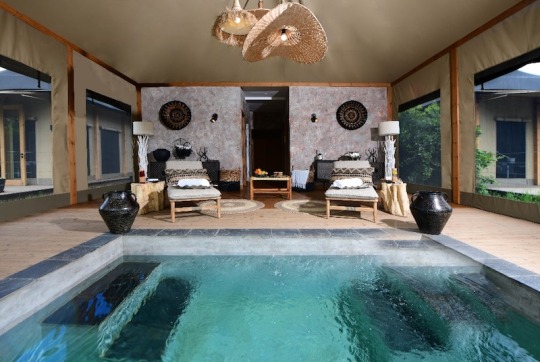
JW Marriott Masai Mara Lodge Officially Open
Transformative Experiences and Meaningful Connections Await at JW Marriott's Haven of Luxury in the Heart of the Masai Mara National Reserve in Kenya
JW Marriott, part of Marriott Bonvoy's global portfolio of 30 extraordinary hotel brands, today announced the opening of JW Marriott Masai Mara Lodge, marking the company's highly anticipated debut in the luxury safari segment.

Sitting within the Masai Mara National Reserve in Southwestern Kenya, one of Africa's most renowned wildlife and wilderness conservation regions, the lodge is a sophisticated and thoughtful sanctuary from which to discover nature and breathtaking vistas in harmony. Exhilarating guided game drives offer guests the opportunity to observe the "Big Five" that Masai Mara is home to, including lions, leopards, buffalos, rhinoceros, and elephants. Between June and September, the reserve is host to the annual great wildebeest migration, which sees more than 10 million animals travel a distance of 1,800 miles from the Serengeti in neighbouring Tanzania.

"Fostering meaningful connections and nourishing the soul is at the heart of the JW Marriott brand, so entering the luxury safari segment is a natural next step," said Bruce Rohr, Global Brand Leader, JW Marriott. "Offering our guests once-in-a-lifetime experiences and a deep connection to place, JW Marriott Masai Mara Lodge balances the thrill of a game drive with thoughtful opportunities to switch off and take it all in. We are excited to welcome travellers to a transformative and wellness-forward stay delivered with JW Marriott's legacy of extraordinary hospitality."

Inspired Design
The lodge's elegant interiors, designed by Kristina Zanic Consultants, seamlessly blend the savannah inwards, drawing inspiration from the elements with soft, warm tones, natural materials and textures, and native colours thread through its design. Each of the lodge's 20 private tents provide a peaceful sanctuary to recharge and reset, and feature terraces overlooking the River Talek, a water source and habitat for many wildlife. The tented honeymoon suite offers a private plunge pool, while two interconnecting king and twin suites are ideal for families with children over the age of six (the minimum age of guests at the lodge).
Wellbeing and Mindful Practices
In keeping with JW Marriott's ethos of mindfulness, the lodge is home to a number of thoughtfully designed spaces from the cosy Adventure Lounge full of books to get lost in and a space for young adults to take time for themselves, to the Cultural Deck where guests can gather around the fire pit to share tales of the day's exploration.
Capturing the essence of rejuvenation, the Spa by JW emulates the serenity of the reserve and offers tailored experiences and signature treatments which blend locally inspired techniques and therapies. These are complemented by natural and organic products by renowned African skincare brand, Healing Earth, also available as in-room amenities. Guests can enjoy spa treatments from the comfort of their tented suite, accompanied by the sounds of the wilderness. Extending beyond body to mind and spirit with guided yoga, treatments include a 'Masai Celebration' incorporating local botanicals and therapies.
Nourishing Culinary Journeys
At the heart of the camp is the JW Garden - an outdoor space for guests to spend time discovering home-grown, organic ingredients, including the lodge's signature rosemary. The garden's produce is used by the lodge's chefs to craft personalised dishes, cocktails, and mocktails. The garden will host daily programming, including live cooking, interactive cocktail mixology, and chef-led talks for a true farm-to-table experience. A relaxing gathering place, Fig Tree Lounge offers panoramic views of the surrounding plains from the indoor and outdoor bar and serves refreshing cocktails and mocktails infused with seasonal ingredients from the lodge's garden. An indoor and alfresco dining experience at Sarabi Restaurant takes guests on a nourishing epicurean experience guided by JW Garden ingredients and local culinary heritage. Guests can venture out into the reserve with the lodge's guides to enjoy a freshly prepared 'Bush Breakfast' or dinner while sipping sundowners and soaking in the breathtaking savannah vistas.
Connection to the Locale
The lodge's community programming provides an authentic insight into meaningful local projects, including The Maa Trust, an organisation empowering local people by promoting small business start-ups. The lodge donates a percentage of the nightly rate per person to the organisation and provides a space for craftspeople to retail Maa Beadwork and produce. Guests can visit The Maa Trust to meet with local artisans and forge a deeper connection to the people in the area.
Currently, 60 percent of the lodge's team are locals, with plans to reach 70 percent, ensuring the hotel's contribution to the socio-economic development of the region. As an ongoing initiative, JW Marriott Masai Mara's Apprenticeship Programme invites young women from the community to diversify their skills and broaden their experience to kick-start their careers in the hospitality industry. Partnership with the community began during the early development process of the lodge. Developed on land committed to a tourism project so as not to unduly disturb the surrounding environment, much of the construction was undertaken by local experts overseen by technical specialists, with build materials sourced from sustainable suppliers. The lodge has rehabilitated access roads to the property, installed power to the area, and provided access to clean drinking water for locals through a water treatment plant.
Emphasis on waste reduction and recycling is integral to daily operations. The lodge's water treatment plant provides recycled and sanitised water; food waste is placed at the lodge's compost site; and water wells are dotted around the lodge for animals to quench their thirst throughout the day.
By supporting local organisations such as The Mara Elephant Project and The Mara Protector Conservation Programme, JW Marriott Masai Mara Lodge contributes to protecting animals and their habitat across the greater Mara ecosystem. Bringing a passion for the surrounding wildlife and nature to guests, the lodge's Head Guide is a lifelong conservationist who holds talks about local culture at the lodge as well as guided walking tours. With an abundance of meaningful moments to experience at the lodge, guests can delve into photography and learn new skills at the lodge's very own studio.
JW Marriott Masai Mara Lodge is a 30-minute drive from Keekorok Airstrip and a 25-minute drive from Sekenani Main Gate.
Bookings for JW Marriott Masai Mara Lodge are now open with prices from $1450 per person, per night (all-inclusive board basis). For more information, visit www.marriott.com.
Read the full article
0 notes
Text
Vegan Resources
I hope the following list will be of some help for existing vegans or those considering making the transition. It is an ongoing work and will be updated regularly, if you spot a link which doesn’t work or you have suggestions for additional resources to include here then please feel free to get in touch.
Videos and Documentaries
Earthlings (Animal rights, graphic)
Land of Hope and Glory (UK animal agriculture, graphic)
Cowspiracy (Environment, one short slaughter scene)
What The Health (Health, nutrition)
Meat the Truth (Meat production, graphic)
Farm to Fridge (Meat production, graphic)
Food Inc. (meat production, graphic)
Blackfish (Animals in captivity, some upsetting scenes)
Vegucated (animal agriculture, some upsetting scenes)
Simon Amstell’s Carnage (fiction, satire, graphic scenes)
Okja (fiction, some upsetting scenes)
Live and Let Live (Vegan testimonials)
Vegan: Everyday Stories (vegan testimonials)
Licenced to Kill (animal research, graphic)
Benjamin Zephaniah on Veganism (advocacy, some distressing scenes)
Melanie Joy: The Psychology of Meat (lecture, advocacy)
Melanie Joy: Effective Vegan Advocacy (lecture, advocacy)
Modern Warrior (TED talk, animal rights)
Uprooting the Leading Causes of Death (lecture, health)
Vegan 2015, Vegan 2016, Vegan 2017 (positive, short documentaries)
Reports and Studies
Livestock’s Long Shadow UN Report
World Watch Institute Report on livestock and climate change
The Cambridge Declaration on Consciousness
World Bank causes of amazon deforestation report
Sustainability of meat-based and plant-based diets
CDC Report: Effect of animal agriculture on communities
Chatham House thinktank report on meat and climate change
Animal agriculture water usage report
The Role of Animal Agriculture in World Hunger report
Slaughterhouse workers human rights report
American Dietetic Association report
NHS on vegan diets
U.S National Library of medicine on vegan/vegetarian diets
American Journal of Clinical Nutrition on vegan diets
Key findings of The China Study
UN report on impact of meat on health
WWF report on biodiversity loss caused by meat based diets
Bioscience report on animal agriculture water resource use
Water Footprint Network comparison of crop and animal products
Global assessment of water footprint of animal products
Science direct report on water footprint of poultry, pork and beef
National Academy of sciences biomass and gas emissions report
Report on well-being of slaughterhouse workers
Articles
Awakening from the nightmare of zoos
Study suggests processed meat a real health risk
Animal agriculture “a leading cause of everything”
Vegan prison reducing agression in inmates
Livestock methane pushes climate change
Meat and cheese linked to earlier death
UN urges move to global meat and dairy-free diet.
What is a vegan- beginner’s guide
Why I become vegan and why you should too
Why vegans always tell you they’re vegan
It’s time to stop apologising for your veganism
Black vegans step out, for their health and other causes
Abolishing meat: An idea whose time has come
Vast animal-feed crops to satisfy meat needs destroying planet
World largest meat company profits drop 80%
We are entering the post-milk era
Rise of the mega farm in Britain
ASA clears advert branding milk inhumane
Thousands of seals shot to keep salmon industry going
If we really love animals we should close all zoos now
Free range is a con: no such thing as ethical eggs
It’s official: Fish feel pain
Processed meat ranks alongside cigarettes for causing cancer
Meatonomics: Bizarre economics of meat and dairy industry
Rethinking the meat guzzler
Brazil's Indigenous Tribes Hunted by Cattle Ranchers
Budgeting Tips
Guide to going vegan on a budget
Cheap vegan groceries list
Tips for eating vegan on a budget
Plant based on a budget challenge
Vegan on a food stamp budget
Cheap vegan college meals
Vegan in college
Vegan college dorm food
The collegiate vegan
Cheap vegan meal ideas
Eating vegan on the cheap
Vegan on a budget
Cheap vegan blog
Vegan spoons and pennies
Low-cost vegan meal plans
$25 a week vegan meal challenge
Plant based on a budget
Health and Nutrition
How to be healthy on a vegan diet
Getting all of your nutrients on a vegan diet
How to lose weight as a vegan
Nutrition Facts
How to gain weight as a vegan
High calorie vegan foods
Vegan sources of iron
Iron in the vegan diet
Vegan sources of protein
Vegan sources of calcium
Vegan sources of fiber
Vegan sources of amino acids
Vegan sources of omega 3
B12 in the vegan diet
What you should know about B12
Vegan sources of fats
Training on a vegan diet
Recipes
Cheap vegan recipes
Vegan Recipe Club
Plant based on a budget
Vegan Sandra
Vegan Richa
Oh she glows
Vegan yack attack
BBC good food
I Love Vegan
100 easy vegan foods
Vegangela recipes
Vegan recipes for beginners
Jamie Oliver’s vegan recipes
Vegan recipes club
Vegan cooking
Vegan baking
Easy tofu recipes
Tofu dishes
Tempeh dishes
Beans and rice recipes
Raw vegan recipes
Vegan Society Recipes
Vegan starters
Vegan main dishes
Vegan desserts
Books
Eating Animals
Why We Love Dogs, Eat Pigs and Wear Cows
The Case for Animal Rights
Animal Rights: A Very Short Introduction
Animal Rights: The Abolitionist Approach
Animal Equality: Language and Liberation
A Plea For The Animals
The Sexual Politics of Meat: A Feminist-Vegetarian Critical Theory
We Animals
Uncaged
Project Animal Farm
Striking at The Roots: A Practical Guide to Animal Activism
Bleating Hearts: The Hidden World of Animal Suffering
Dominion
Slaughterhouse
When Elephants Weep: The Emotional Lives of Animals
Beyond Words: What Animals Think and Feel
Animal Rights: Current Debates and New Directions
Keep it Vegan: Over 100 Simple, Healthy & Delicious Dishes
Vegan Cupcakes Take Over The World
Vegan Pie in The Sky
Veganomicon: The Ultimate Vegan Cookbook
Oh She Glows Cookbook
The Rawsome Vegan Cookbook
The Happy Vegan
The Vegan Cheatsheet
Change of Heart
How Not to Die
V is For Vegan: The ABC’s of Being Kind
Websites
Vegankit
Vegan.com
Vegan health
Veganacious
Vegan Sidekick
Go Vegan
Live vegan
Busy Vegan
Minimalist Vegan
How Do I Go Vegan
21 Day Vegan Kickstart
The Abolitionist Approach
Veganuary
Live Kindly
Movement For Compassionate Living
Cruelty Free Kitty
Barnivore
Meat.org
Animal Rights About
Veganeasy
My vegan finder
Plant Based News
Great Vegan Athletes
Vegan Life Magazine
The vegan calculator
Happy Cow
Vegan Voices of Color
Vegan Parenting Network
Vegan Feminist Network
Veganic Agriculture Network
Organisations
The Vegan Society
International Vegan Association
Mercy For Animals
Vegan Outreach
Evolve! Campaigns
Surge
Centre For Animals and Social Justice
Cruelty Free International
Choose Cruelty Free
Animal Aid
Compassion Over Killing
Toronto Pig Save
Friends of Animals
Farm Sanctuary
Animal Place
Happily Ever Esther Farm Sanctuary
Gentle Barn
Micro Sanctuary Movement
Animal Free Research
Animal Liberation Front
Sea Shepherd
Hunt Sabs UK Directory
Hunt Saboteurs Association
1K notes
·
View notes
Link
No white tiger cubs left at Lahore Zoo as last two die of sickness Two white tiger cubs look at the camera for a photo. AFP/Fred Dufour/Files LAHORE: The Lahore Zoo has no white tiger cubs anymore as the last two have died of sickness, coupled with the alleged negligence of the facility’s authorities, Geo News reported on Thursday, in what becomes the latest case of reported maltreatment of animals in Pakistani zoos. Lahore Zoo Director Chaudhry Shafqat said both cubs were three months old and had been sick for the past two months. Three months ago, the female white tiger had given birth to three cubs, one of which had died right away due to weakness, Shafqat explained. “The remaining two cubs were sick for the past two months and died today,” he added. The two three-month-old white tiger cubs that died at Lahore Zoo in Lahore, Pakistan, February 4, 2021. Geo News/via The News The Lahore Zoo director claimed that their mother was not taking care of them. Pakistan’s zoo animals have long been a topic of discussion for activists and advocates who have repeatedly highlighted poor conditions in such facilities. Kaavan Late last year, Kaavan — formerly the world’s “loneliest elephant” — was shifted to a new home at the Kulen Promtep Wildlife Sanctuary in Cambodia’s Preah Vihear province after years of activists, including pop singer Cher, campaigning for his freedom. The poor animal had been kept in chains at Islamabad’s Marghazar Zoo, exhibiting symptoms of mental illness. A medical examination prior to his move to Cambodia indicated that animal’s nails were cracked and overgrown due to years of living in an improper enclosure with flooring that damaged his feet. Kaavan’s sickness and loneliness had prompted global outrage over his treatment and a petition demanding his release garnered over 400,000 signatures. He was moved to the Cambodian sanctuary with much applause across Pakistan and made contact with another of his species after eight long years. Multiple animals dead at Marghazar Zoo Prior to that, in July 2020, the Islamabad High Court (IHC) heard that numerous animals had died of negligence and other preventable causes at the Marghazar Zoo. The lioness there had died earlier the same day and the lion was nearing death, with sources informing Geo News that the deceased animal had sustained injuries due to the staff’s mismanagement during its transfer from Marghazar Zoo to Lahore. A video obtained by Geo News showed mismanagement at the zoo while the lion was being taken out of its cage. According to the clip, zoo staff set fire in the cage and used sticks to scare off the animal but it got frightened and confused instead. Sources had further underlined how several animals — including deer, birds, three Belgian Blue cows, as well as an ostrich — were injured during transfers. ‘Our heads should hang in shame’ Zoo officials had admitted that six deer died during transfers; these included two spotted deer, two elks, and one Indian gazelle. They had acknowledged that a Belgian Blue cow, as well as a lion, lioness, and ostrich each had also died. Officials had said at the time the ostrich had died due to a cloth being tied over its face. During the hearing at the Islamabad court, IHC Chief Justice Athar Minallah slammed the Ministry of Climate Change for “politicking” over the animals, saying “our heads should hang in shame”. The top judge observed that at least 40 giraffes were brought to the zoo from abroad and “all of them are dead”. https://timespakistan.com/no-white-tiger-cubs-left-at-lahore-zoo-as-last-two-die-of-sickness/10246/
0 notes
Text
Net-A-Porter & Gemfields Team Up With Elephant Conservationists On A Collection That Gives Back
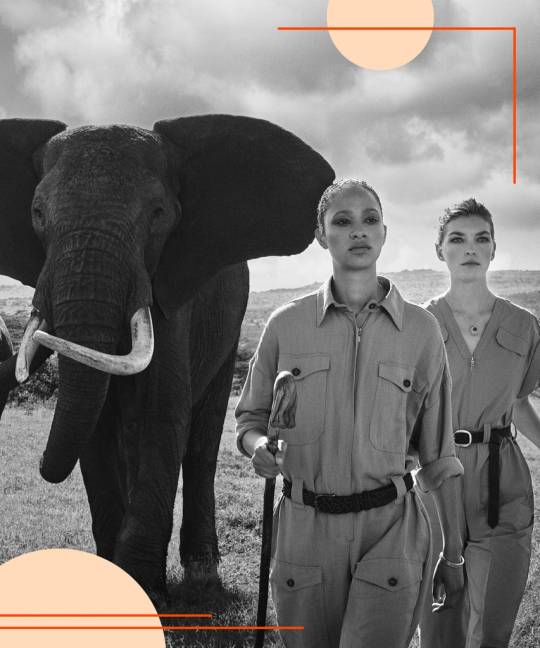
Over the last six months, the pandemic has caused a steep decrease in tourism and philanthropic funding to Africa — and those on the frontlines protecting animal habitats from poachers have witnessed a significant increase in the wildlife trade. Luckily, Space for Giants, a nonprofit dedicated to protecting African elephants and their natural environments, is working tirelessly to stop them. Now, they’re not alone: On Monday, Space for Giants launched Walk for Giants, a multi-layered collaborative campaign with Net-A-Porter and Gemfields. To kickstart the campaign, the nonprofit released two exclusive capsule collections: a 15-piece sustainable collection to be sold on Net-A-Porter and a 44-piece collection of responsibly-sourced coloured gemstones courtesy of Gemfields. 100% of the proceeds from both collections will go toward supporting Africa’s elephants and their natural habitats. Some of the items include a Hereu canvas and leather tote bag, a Burberry safari jacket, and an emerald-cut ring designed with Mozambican rubies.
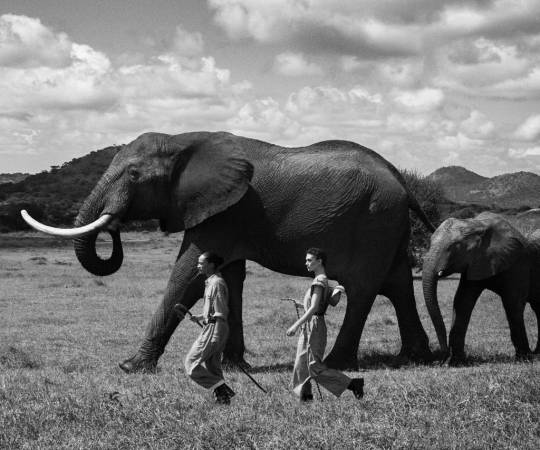
The idea for Walk for Giants came to the nonprofit’s founder, Dr. Max Graham, during a trip to Kenya prior to the pandemic. While there, Dr. Graham walked the Ewaso Ng’iro river, the “lifeblood to Kenya’s second biggest elephant population, most of the wildlife in central Kenya, and many of the Kenyan people,” with former Stylebop fashion director Leila Yavari and supermodel Lena Perminova, as well as a number of other philanthropists and influential people, to show them the elephant migration route that the species has taken for nearly 60 years. During the four-day journey, questions arose about how the fashion industry could be of help to Space for Giants, and vice versa: “How do we connect this experience with the fashion industry to create a much broader audience for these issues? How can we help brands come on board and become more compelling to their customers, but through that process, give back?”
“The concept can be boiled down into a very simple question: How can we turn a unit of consumption into a unit of conservation?” Dr. Graham explains. The founder, with the help of Yavari and Perminova, has been building the Walk for Giants campaign ever since.
View this post on Instagram
LAUNCHING WALK FOR GIANTS We are thrilled to announce our latest initiative – Walk for Giants -presented by @spaceforgiants and @gemfields, supported by @netaporter. Walk for Giants is a movement, supported by fashion, to demand global action to protect nature forever. Today’s kick-off includes the release of two exclusive capsule collections by both Gemfields and Net-a-Porter in support of the campaign. All proceeds from these capsule collections will provide critical support to protect Africa’s natural landscapes and their wildlife. The release of these capsule collections marks the launch of the Walk for Giants campaign which will culminate in an immersive conservation journey along an ancient elephant migration corridor, with some of the world’s most influential individuals, to raise awareness and funding for the protection of Africa’s iconic wildlife and the critical natural ecosystems they depend on. @gemfields @netaporter #walkforgiants #spaceforgiantsxgemfields #walkthewalk Photographer: @francescocarrozzini Creative Director: @riccardoruini Models: @selenaforrest @arizona_muse Hair: @laurentphilippon Make-up: @lilichoimakeup Stylist: @hels_broadfoot Location: @enasoit
A post shared by Space for Giants |Conservation (@spaceforgiants) on Aug 17, 2020 at 2:25am PDT
The corresponding photoshoot, which features both collections, not to mention two elephants, took place at Enasoit Game Sanctuary in Kenya, which is located at the crossroads of a number of animal routes. “You can watch the procession all day,” Dr. Graham says. “It was an astonishing place to do the shoot.” Space for Giants tapped renowned fashion photographer Francesco Carrozzini and creative director Riccardo Ruini to elevate the Walk for Giants campaign, while models Selena Forrest and Arizona Muse were chosen as its faces. “Selena represents youth,” Dr. Graham says of Forrest. “She represents a lot of hope within her community, and I think she’s passionate about Africa and she’s passionate about conservation.” Another reason for choosing Forrest was to bring a younger, more vibrant audience to the conservation effort, which Dr. Graham says is “a bit stale.” “In many ways, [Forrest] represents a real opportunity to make the industry more mainstream and communicate to an audience who we wouldn’t normally speak to.” As for Muse, Dr. Graham calls her the “bonafide face of sustainability in fashion,” making her an obvious partner for the campaign.
Once it’s safe to travel again, Dr. Graham plans to hold a second walk along the Ewaso Ng’iro with some of fashion’s most influential individuals in an effort to raise awareness and funding for Africa’s natural ecosystems. “The fashion industry has a bit of an image problem around the environment,” Dr. Graham says. “However, it’s also very, very powerful — it’s one of the biggest industries in the world.”
Dr. Graham founded his nonprofit Space for Giants in 2010 after a number of the Kenyan elephants he’d been tracking and studying as part of his Ph.D. studies at Cambridge University were killed by poachers. “It really hit home to me, both how vulnerable elephants were to the illegal wildlife trade, and also just how little value they and their habitats have in terms of creating custodians among local people and national governments in Africa,” Dr. Graham says. Today, when the issue of wildlife poaching has once again seen a spike in popularity, it’s more important than ever to protect the natural ecosystems that hold elephants and other wildlife.
Shop both charitable collections today on Net-A-Porter.com and Gemfields.com and learn more about Dr. Graham’s mission at SpaceforGiants.org.
Like what you see? How about some more R29 goodness, right here?
The Best Of The Net-A-Porter Summer Sale, From £28
21 Homeware Pieces That Give Back To Charity
How The NHS Became The Coolest 'Brand' In Britain
Net-A-Porter & Gemfields Team Up With Elephant Conservationists On A Collection That Gives Back published first on https://mariakistler.tumblr.com/
0 notes
Text
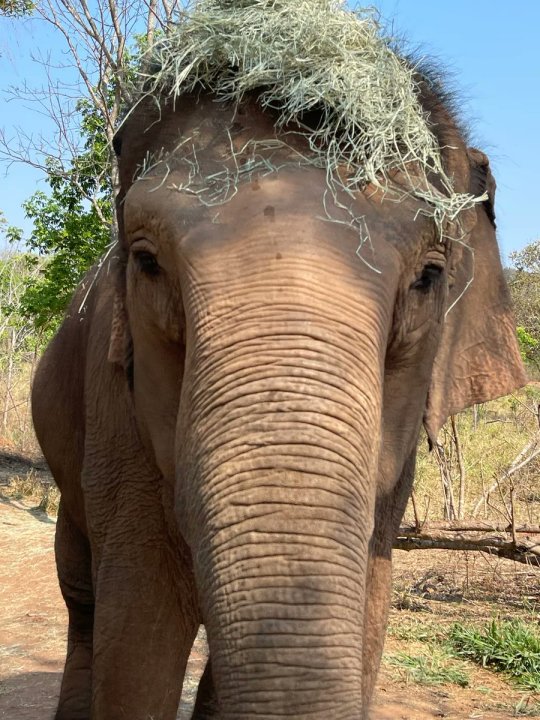
Day 237 of posting pictures of elephants.
Do you like her hat?
#elephants#cute animals#cuteness#elephant#adorable#image of the day#not my image#wildlife#cuteness overload#nature#source: Global Sanctuary for elephants#grass hat
159 notes
·
View notes
Photo

Photos by @amivitale. I am honored to share this beautiful story from Reteti Elephant Sanctuary (@r.e.s.c.u.e) in northern Kenya that @cnn just published. For years, baby elephants lived off powdered formula — the same used for infant humans — at the Reteti Elephant Sanctuary in northern Kenya. But when global supply chains were severely disrupted by the coronavirus, the sanctuary had to find a more dependable source of food for its calves, who had been either orphaned or abandoned. Fortunately, the answer was right in their backyard. The sanctuary experimented and then moved to using local goat's milk instead of the expensive formula shipped from thousands of miles away. It’s also brought about a shift in the relationship between the community and the calves. Not only is it more nutritious for the elephants, it is also more sustainable for the planet and it is empowering the women in the community who are benefitting from this new source of income. Please view the whole story now at CNN.com and consider donating to this amazing place (link in profile.) #elephants #nikonambassador #nikonnofilter #kenya #northernkenya #goats #milk @r.e.s.c.u.e @sararafoundation https://www.instagram.com/p/CbZDkMgsxR6/?utm_medium=tumblr
17 notes
·
View notes
Text
Ten Animals and Plants Around the World That You Can (Virtually) Adopt
https://sciencespies.com/nature/ten-animals-and-plants-around-the-world-that-you-can-virtually-adopt/
Ten Animals and Plants Around the World That You Can (Virtually) Adopt

One of the positive developments that has come about during the COVID-19 pandemic is that more animals are being adopted than usual, in particular dogs and cats. However, plenty of other animals (and plants) around the world—many of which are threatened or endangered—need help, too. Here are ten species that are up for (virtual) adoption.
Saguaros, Arizona

Sagauro cactus in Saguaro National Park, Arizona
(Epics/Getty Images)
The Sonoran Desert in Arizona and Southern California is the only place in the world where saguaros grow. These towering cacti (Carnegiea gigantea) can live up to 200 years and reach 60 feet in height, making it the largest cactus species in the United States. One of the locations where saguaros grow in abundance is Saguaro National Park in Tucson, Arizona, with more than 1.9 million saguaros peppering the arid landscape. To help protect these prickly giants, the Friends of Saguaro National Park, a nonprofit fundraising partner of the National Park Service, has created an adoption program. Starting at $35, proceeds of each adoption go into a protection fund used for researching and maintaining the park’s forest of saguaros. (The organization also offers adoptions of various species living within the park, like coyotes, gila monsters and javelinas.)
Manta Rays, Republic of Maldives
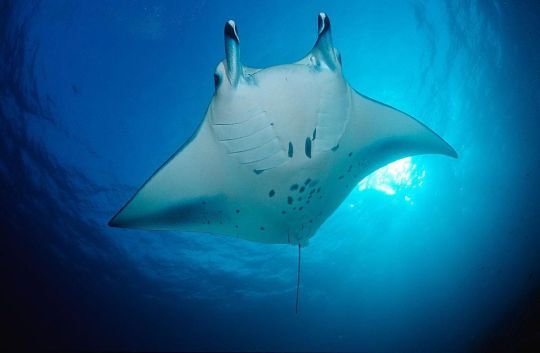
Manta ray at Ari Atoll
(Reinhard Dirscherl/ullstein bild via Getty Images)
The aquamarine waters surrounding the Republic of Maldives are home to the world’s largest known population of manta rays, with numbers hovering around 5,000. These reef-laden tropical waters in South Asia serve as the species’ home base, and from June through November, the Ari Atoll just north of the island nation becomes a major aggregating ground for the winged fish flocking there to feed on zooplankton. Since 2011, the Manta Trust has been working on conservation efforts to help protect the species, which can live up to 50 years in the wild. One of those efforts is through public adoption. For $25, donors can choose from any one of a number of frequently sighted mantas available—Mrs. Flappy, Spiderman and George the Giant to name a few. The Manta Trust’s Maldivian Manta Ray Project has identified more than 4,900 reef manta rays (Mobula alfredi) based on the unique spot patterns on their undersides. Donors receive a digital adoption packet that includes details specific to that individual, an activity packet and more.
Galápagos Tortoises, Galápagos Islands

Giant Galápagos tortoises in the highlands of Santa Cruz Island in the Galápagos Islands
(Avalon/Universal Images Group via Getty Images)
The Galápagos tortoise is the largest tortoise in the world, stretching more than 5 feet in length and weighing up to 550 pounds. Due to their vast size, humans began hunting them for their meat centuries ago, severely threatening their survival. (Fortunately, one particularly virile male tortoise helped bring them back from the brink as part of an island-wide breeding program.) Now many efforts are at play to help protect these gentle creatures, which can live more than 100 years in the wild. One organization in particular that’s leading the effort is the Galapagos Conservation Trust, a pioneer in research and conservation that runs an adoption program. For 35 pounds (about $44), donors receive an information packet about the species, a personalized certificate of adoption and a plush toy. The trust also offers adoptions of sea lions, hammerhead sharks and other species found around the archipelago.
Mountain Gorillas, Central Africa

Mountain gorillas in Virunga National Park in the Democratic Republic of the Congo
(Brent Stirton/Getty Images)
The future of the mountain gorilla, a species of great ape inhabiting the mist-blanketed mountains of central Africa, remains in jeopardy. The International Union for Conservation of Nature (IUCN) currently classifies it as an endangered species, with less than 1,200 remaining in Uganda, Rwanda and the Democratic Republic of the Congo. Human interference from poaching and deforestation has taken a toll on the giant herbivores, who feed on stems, roots and other greenery found throughout their forest habitat. To help ensure the survival of future generations of this species, the Gorilla Organization manages an adoption program that, starting at less than $4 per month, provides funding to support a variety of conservation projects, from reducing hunting snares to creating gorilla safe zones. Adopters receive an adoption certificate and news about their individual gorilla, as well as either a T-shirt or a plush toy.
Coral Reefs, Bermuda
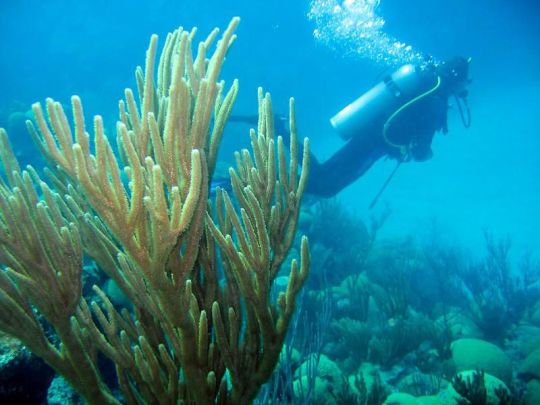
Scuba diving in Bermuda
(Flickr user Curtis & Renee)
While coral bleaching due to rising water temperatures has been a global issue for a number of years, the reefs surrounding Bermuda remain relatively unscathed thanks to the island’s more temperate climate. Unfortunately, other outside sources, such as the construction of the local airport in the 1950s, have left some of the reefs severely damaged, infringing on an ecosystem that many underwater dwellers like blue angelfish and barracudas rely on to survive. To help maintain the current reefs while also planting new coral gardens, Living Reefs launched its “Adopt a Coral Garden” project in 2016. In exchange for a donation of $600 for a mini garden or $150 for a single polyp, adopters receive a ceramic plaque enscribed with their name. Those interested can inquire here.
Sequoias, Northern California

Giant sequoias in California’s Sequoia National Park
(Marji Lang/LightRocket via Getty Images)
Found towering along the western slope of the Sierra Nevada mountain range predominately in Northern California, sequoias are some of the tallest trees and oldest living organisms on the planet, reaching heights of 300 feet and living up to 2,000 years. As part of its conservation efforts, Sequoia ForestKeepers manages an adoption program with funding that goes toward a variety of different programs, such as data collection on the health of the trees and sustainable land management practices. For $100 for a single tree or $2,500 for a stand of sequoias, donors receive a certificate of adoption, GPS coordinates and a map showing the location of the adopted tree, and an 8-by-10-inch photo of the sequoia.
Asian Elephants, Thailand

Elephants rescued from the tourism and logging trade gather at the Elephant Nature Park in the northern Thai province of Chiang Mai.
(Lillian Suwanrumpha/AFP via Getty Images)
Since 2001, the Wildlife Friends Foundation Thailand has been instrumental in the conservation of Asian elephants, an endangered species whose numbers have been severely depleted over the years due to poaching and deforestation. According to the WFFT, 97 percent of the continent’s elephant population has already been lost, with approximately 2,000 individuals remaining in the wild. The WFFT maintains the Elephant Refuge, a rescue facility about 100 miles southwest of Bangkok that is home to several dozen elephants saved from mistreatment in the tourism industry, where they were forced to give rides and entertain the public. As part of the foundation’s adoption program, which starts at $38, donors receive an adoption certificate plus periodic email updates on their adopted elephant.
West Indian Manatees, Florida

A manatee moves slowly in Florida’s Crystal River and Homasassa Spring.
(Frogfish Photography/Barcroft via Getty Images)
Despite being downgraded on the endangered species list in 2017, West Indian manatees are still a threatened species protected under a number of laws, including the Marine Mammal Protection Act of 1972 and the Florida Manatee Sanctuary Act of 1979. Today roughly 5,700 of these gentle mammals (often called sea cows) float in Florida’s waterways, and although they have no known natural enemies, they are susceptible to human interference, particularly collisions with watercraft and water pollution. The nonprofit Save the Manatee Club has been doing its part since 1981 to educate the public about the species’ vulnerabilities as well as to protect these mammals and their warm-water habitats. One way to help is through the club’s Adopt-a-Manatee program. For $25, donors receive an adoption certificate; a photo of a manatee that frequents spots like Blue Spring State Park, Homosassa Springs State Park and Tampa Bay; a subscription to a Manatee Zone newsletter and a membership handbook.
Horseshoe Crabs, Delaware Bay

Horseshoe crabs in Mispillion Harbor, Delaware
(Gregory Breese/U.S. Fish and Wildlife Service)
Horseshoe crabs can be found crawling along the shores of the Atlantic Ocean from Maine to as far south as the Yucatán Peninsula in Mexico. But their favorite breeding ground has remained the same for ages: the Delaware Bay. Each spring, beginning in late April or early May, tens of thousands of these arthropods, whose history stretches back some 400 million years earning them the much-deserved title of “living fossils,” descend on this stretch of sand to lay their eggs. But despite the species’ longevity, they still need the help of conservation efforts. The New Jersey-based nonprofit Wetlands Institute estimates that Delaware Bay’s horseshoe crab population has decreased by 90 percent over the last 150 years due to overharvesting. Though the practice is on the decline, humans historically extracted blood from horseshoe crabs, because its sensitivity to endotoxins made it crucial, before a synthetic substitute was developed, for testing for bacterial contamination on medical devices. Wetlands Insitute created an adoption program to help. Starting at $25, adopters receive a digital photo of a horseshoe crab and adoption certificate, plus a copy of its annual newsletter.
Kiwis, New Zealand
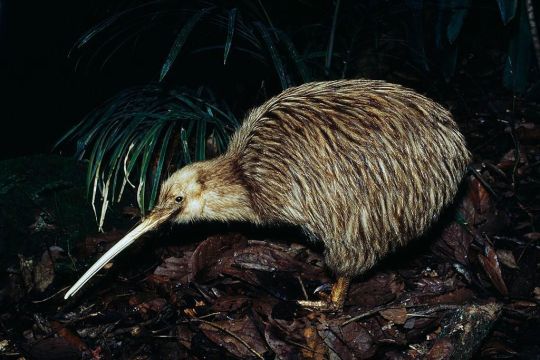
Little spotted kiwi on South Island, New Zealand
(DeAgostini/Getty Images)
Native to New Zealand, kiwis are synonymous with the island country. The Maori, the first people to live on the island, named the bird, which is now New Zealand’s national bird. Since 1971, Otorohanga Kiwi House has been protecting these flightless birds. Approximately 70,000 kiwi remain in the wild today, and because they can’t fly, they’re particularly vulnerable to predators. To help protect their numbers from further decline, Kiwi House offers an Adopt a Kiwi House Critter program. Available birds include the great spotted kiwi and the brown kiwi, two of the five kiwi species found in New Zealand. Adoptions cost $60 per year, and the funds go toward conservation efforts, such as breeding programs. Adopters receive an adoption certificate, plush toy and one free admission to view their adopted bird in person at the facility.
#Nature
#05-2020 Science News#2020 Science News#Earth Environment#earth science#Environment and Nature#Nature Science#News Science Spies#Our Nature#outrageous acts of science#planetary science#Science#Science Channel#science documentary#Science News#Science Spies#Science Spies News#Space Physics & Nature#Space Science#Nature
0 notes
Text
26-04-2020 Current Affairs & Daily News Analysis

Vignan IAS Coaching institute in Bangalore
VENTILATOR INTERVENTION TECHNOLOGY ACCESSIBLE LOCALLY (VITAL)
NASA engineers have developed a new, easy-to-build high-pressure ventilator tailored specifically to treat COVID-19 patients.

About:
The device, called VITAL (Ventilator Intervention Technology Accessible Locally), is designed to treat patients with milder symptoms, thereby keeping country's limited supply of traditional ventilators available for patients with more severe COVID-19 symptoms.
VITAL can be built faster and maintained more easily than a traditional ventilator, and is composed of far fewer parts, many of which are currently available to potential manufacturers through existing supply chains.
NASA is now seeking FDA approval for the device via an emergency use authorization, a fast-track approval process developed for crisis situations that takes just days rather than years.
Source : All India Radio ( Science & Technology)
Vignan IAS Coaching institute in Bangalore
India Credit Risk Fund
Amid the severe market dislocation and illiquidity caused by the COVID-19 pandemic, Franklin Templeton Mutual Fund, the ninth largest in the country, has decided to wind up six yield-oriented managed credit funds, one of them being a credit risk fund.

About:
Credit risk funds are debt funds that play on the principle of high-risk-high-reward.
By definition, credit funds invest 65 per cent of the portfolio in bonds that are AA rated or below, and investors must be aware that they are investing in schemes that are investing in lower-rated papers.
While higher-rated bonds of companies are more secure and offer lower interest rates, credit risk funds generally invest in lower-rated bonds which offer higher return but also carry a higher risk.
Fund managers can lower their risk by following a higher diversification strategy.If the scheme is diversified significantly on the asset side, then even if there is a default by one or two companies, the entire portfolio does not get affected.
if the scheme is well diversified on the liability side, then even if one or two investors seek redemption, it does not push the fund house to sell.
Source : Indian Express ( Economy)
Vignan IAS Coaching institute in Bangalore
Asymptomatic Transmission, the Achilles’ Heel of Current Strategies to Control Covid-19
There is debate whether some people can spread COVID-19 before showing symptoms themselves?
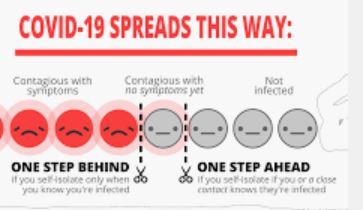
About:
The WHO recognises three stages of COVID-19 transmission — asymptomatic, presymptomatic and symptomatic.
Symptomatic transmission refers to transmission from a person while they are experiencing symptoms.
Presymptomatic transmission is when a person spreads the disease before symptoms appear, and eventually develops symptoms themselves.
Asymptomatic transmission refers to transmission of the virus from a person, who does not develop symptoms. There are few reports of laboratory-confirmed cases who are truly asymptomatic, and to date, there has been no documented asymptomatic transmission.
Important Info :
• According to the US Centers for Disease Control and Prevention (CDC) is clear that both presymptomatic and asymptomatic transmission of the coronavirus are possible.
Source : Indian Express ( Health )
Vignan IAS Coaching institute in Bangalore
PRACRITI
Researchers at the Indian Institute of Technology in Delhi have developed a web-based dashboard for predicting the spread of COVID-19 in India.

About:
The mobile-friendly dashboard, PRACRITI (PRediction and Assessment of CoRona Infections and Transmission in India) gives detailed State-wise and district-wise predictions of COVID-19 cases in India for a three-week period, which is updated on a weekly basis.
PRACRITI provides the R0 values of each district and State based on data available from the Ministry of Health and Family Welfare, National Disaster Management Authority, and the World Health Organization.
Important Info :
R naught?
A key parameter of interest on COVID-19 is the basic reproduction number (R0), pronounced ‘R naught’ and its countrywide variability.R0 refers to the number of people to whom the disease spreads from a single infected person. For instance, if an active COVID-19 patient infects two uninfected persons, the R0 value is two.Reduction of R0 is key in controlling and mitigating COVID-19 in India.
Source : The Hindu ( Health )
Vignan IAS Coaching institute in Bangalore
RED, ORANGE AND GREEN ZONES -COVID-19
Government has categorised the country into three zones namely red, orange and green zones depending on the number of coronavirus cases during the lockdown period.

About:
The green zones are those where no new cases were reported over 28 days since the last case tested negative.
The orange zones are those with a few cases, and the red ones have a large number of cases.
The government suggests opening up the green zones first. But these zones may have many asymptomatic cases, that is, infected people with no symptoms.
Source : Indian Express (Health)
Vignan IAS Coaching institute in Bangalore
INTERNATIONAL CHERNOBYL DISASTER REMEMBRANCE DAY
In 2016 the United Nations General Assembly adopted a resolution designating 26 April as International Chernobyl Disaster Remembrance Day.

About:
The Chernobyl disaster was a nuclear accident that occurred on 26 April 1986, at the No. 4 reactor in the Chernobyl Nuclear Power Plant, near the city of Pripyat in Ukrainian SSR.
An explosion at the Chernobyl Nuclear Power Plant in 1986 spread a radioactive cloud over large parts of the Soviet Union, now the territories of Belarus, Ukraine and the Russian Federation. Nearly 8.4 million people in the three countries were exposed to the radiation.
It is considered the worst nuclear disaster in history and is one of only two nuclear energy disasters rated at seven—the maximum severity—on the International Nuclear Event Scale, the other being the 2011 Fukushima Daiichi nuclear disaster in Japan.
Source : United Nations ( Disaster Management)
Vignan IAS Coaching institute in Bangalore
WORLD INTELLECTUAL PROPERTY DAY 2020
World Intellectual Property Day 2020 is being celebrated on April 26 with the theme “Innovate for a Green future”.

About:
World Intellectual Property Day is observed annually on 26 April.
The event was established by the World Intellectual Property Organization (WIPO) in 2000 to "raise awareness of how patents, copyright, trademarks and designs impact on daily life."
26 April was chosen as the date because it coincides with the date on which the Convention Establishing the World Intellectual Property Organization (WIPO) entered into force in 1970.
Important Info :
World Intellectual Property Organization (WIPO)?
What is it? WIPO is the global forum for intellectual property (IP) services, policy, information and cooperation.Type: WIPO is a specialized agency of the United Nations.Established in: 1967. Headquarters: Geneva, Switzerland.Membership: 193 member states.Parent organization: United Nations Economic and Social Council.
Source : WIPO ( International)
Vignan IAS Coaching institute in Bangalore
CHEMICALS AND PETROCHEMICALS INDUSTRY
Union Minister for Chemicals and Fertilizers congratulated the chemicals and petrochemicals industry on becoming the topmost exporting sector of the country for the first time.

About:
He informed that during April 2019 to January 2020, the export of chemicals grew by 7.43 per cent over previous corresponding period.
The total export of chemicals during this period reached 2.68 lakh crore rupees which constitutes 35 per cent of the total exports.
Source : All India Radio ( Economy )
Vignan IAS Coaching institute in Bangalore
g-CNQDs
Institute of Nano Science and Technology (INST), an autonomous institute under the DST has found a low-cost metal-free nanomaterial for visible light microbial disinfection which can be an alternative to silver and other metal-based materials.

About:
Carbon Nitride Quantum Dots (g-CNQDs) are found to be a viable anti bacterial alternative to metal/non-metal semiconductors and expensive silver, thus making it cost-effective.
These nanomaterials possess enhanced biocidal activity attributed to larger surface area of g-CNQDs having more reactive sites and optical absorption both in the ultraviolet and visible region. The g-CNQDs have the ability to generate reactive oxygen species (ROS).
The ROS rapidly interact and damage the immediately available biological macromolecules such as lipids present on the cell membrane or envelope and proteins present on the cellular surface, towards inactivation of the microorganism.
The dependence on visible light is also advantageous over regular ultraviolet mediated disinfection, which requires cautious handling of the UV light-emitting devices.
This technology will also be simultaneously explored for antiviral efficiency considering its relevance to the current scenario.
Source : PIB ( Science & Technology )
Vignan IAS Coaching institute in Bangalore
SALEKI
Amid the countrywide lockdown, the National Board for Wildlife (NBWL) has recommended coal mining by North-Easter Coal Field (NECF), a unit of Coal India Limited in Saleki proposed reserve forest land, a part of an elephant reserve in Assam
About:
The National Board for Wildlife (NBWL) is under the Ministry of Environment, Forest and Climate Change (MoEFCC).
Saleki is a part of the Dehing Patkai Elephant Reserve that includes the Dehing Patkai Wildlife Sanctuary covering 111.19 sq km of rainforest and several reserve forests in Sivasagar, Dibrugarh and Tinsukia districts.
Source : The Hindu (Geography)
Contact Best IAS Academy in Bangalore
Enroll for Foundation Course
Enroll for General Studies Integrated Course
Read UPSC Current affairs and Daily News Analysis from Best IAS Academy in Bangalore Vignan IAS Academy
Discounts on IAS coaching fee in Bangalore
Vignan IAS Coaching institute in Bangalore
Contact Vignan IAS Academy
Read the full article
#26-04-2020VignanIASCurrentaffairs#BestIASAcademyinBangalore#bestiascoachinginbangalore#bestupsccoachinginbangalore#topiascoachinginbangalore#Top5IASCoachinginBangalore
0 notes
Text
Covid-19: Hungry and in chains, Thailand’s tourist elephants face crisis - travel
New Post has been published on https://www.liveindiatimes.com/covid-19-hungry-and-in-chains-thailands-tourist-elephants-face-crisis-travel/
Covid-19: Hungry and in chains, Thailand’s tourist elephants face crisis - travel
Underfed and chained up for endless hours, many elephants working in Thailand’s tourism sector may starve, be sold to zoos or be shifted into the illegal logging trade, campaigners warn, as the coronavirus decimates visitor numbers.
Before the virus, life for the kingdom’s estimated 2,000 elephants working in tourism was already stressful, with abusive methods often used to ‘break them’ into giving rides and performing tricks at money-spinning animal shows.
With global travel paralysed the animals are unable to pay their way, including the 300 kilograms (660 pounds) of food a day a captive elephant needs to survive.
Elephant camps and conservationists warn hunger and the threat of renewed exploitation lie ahead, without an urgent bailout.
“My boss is doing what he can but we have no money,” Kosin, a mahout — or elephant handler — says of the Chiang Mai camp where his elephant Ekkasit is living on a restricted diet.
Chiang Mai is Thailand’s northern tourist hub, an area of rolling hills dotted by elephant camps and sanctuaries ranging from the exploitative to the humane.
Footage sent to AFP from another camp in the area shows lines of elephants tethered by a foot to wooden poles, some visibly distressed, rocking their heads back and forth.
Around 2,000 elephants are currently “unemployed” as the virus eviscerates Thailand’s tourist industry, says Theerapat Trungprakan, president of the Thai Elephant Alliance Association.
The lack of cash is limiting the fibrous food available to the elephants “which will have a physical effect”, he added.
Wages for the mahouts who look after them have dropped by 70 percent.
Theerapat fears the creatures could soon be used in illegal logging activities along the Thai-Myanmar border — in breach of a 30-year-old law banning the use of elephants to transport wood.
Others “could be forced (to beg) on the streets,” he said.
It is yet another twist in the saga of the exploitation of elephants, which animal rights campaigners have long been fighting to protect from the abusive tourism industry.
– ‘Crisis point’ –
For those hawking a once-in-a-lifetime experience with the giant creatures — whether from afar or up close — the slump began in late January.
Chinese visitors, who make up the majority of Thailand’s 40 million tourists, plunged by more than 80 percent in February as China locked down cities hard-hit by the virus and banned external travel.
By March, the travel restrictions into Thailand — which has 1,388 confirmed cases of the virus — had extended to Western countries.
With elephants increasingly malnourished due to the loss of income, the situation is “at a crisis point,” says Saengduean Chailert, owner of Elephant Nature Park.
Her sanctuary for around 80 rescued pachyderms only allows visitors to observe the creatures, a philosophy at odds with venues that have them performing tricks and offering rides.
She has organised a fund to feed elephants and help mahouts in almost 50 camps nationwide, fearing the only options will soon be limited to zoos, starvation or logging work.
For those restrained by short chains all day, the stress could lead to fights breaking out, says Saengduean, of camps that can no longer afford medical treatment for the creatures.
Calls are mounting for the government to fund stricken camps to ensure the welfare of elephants.
“We need 1,000 baht a day (about $30) for each elephant,” says Apichet Duangdee, who runs the Elephant Rescue Park.
Freeing his eight mammals rescued from circuses and loggers into the forests is out of the question as they would likely be killed in territorial fights with wild elephants.
He is planning to take out a two million baht ($61,000) loan soon to keep his elephants fed.
“I will not abandon them,” he added.
Source link
0 notes
Text
Prompt 8: Scientific Heroes
I’ll admit that I had some trouble with this prompt. I’ve had so many people influence my love for nature and biology: interpreters at national parks, wildlife and conservation program presenters, hosts of Animal Planet shows, even teachers that let me go off topic on assignments to work on something that I was more passionate about. But I’m not sure if I would consider any of those people my “scientific heroes.” To get some inspiration, I asked a few friends who their heroes were, and, as you might expect, Bill Nye was a fairly common answer.
Growing up, I never watched Bill Nye the Science Guy; my teachers went straight from Eyewitness episodes to the soothing voice of Sir David Attenborough narrating Blue Planet or Planet Earth. Even though you never saw Attenborough on screen, I suppose I would consider him one of my scientific heroes. I’ve always admired his work on the BBC documentaries and his lifelong contributions towards conservation (contributions so significant that the building housing the University of Cambridge’s conservation hub is named after him).
youtube
Listen to that nostalgic pan flute. Fun fact: the official Eyewitness youtube channel is posting the full episodes of the program. Did I get distracted halfway through writing my response because of this? Yes.
But most people have heard of David Attenborough (or would at least recognize his voice), so I want to focus on a newer scientific hero of mine: Joel Sartore.
Joel is a National Geographic photographer whose work I was introduced to through the PBS miniseries RARE: Creatures of the Photo Ark (which I would highly recommend).
youtube
RARE: CREATURES OF THE PHOTO ARK | Official Trailer | PBS
The Photo Ark is a portrait series with the mission of documenting every species living in zoos and sanctuaries so that there will be a record of the animals that go extinct through climate change. Along with creating an archive for the future, he hopes that this work will inspire people to support conservation by helping them to connect more personally with wildlife:
“Perhaps a series of portraits, made as simply and cleanly as possible, would give us all a chance to look animals directly in the eye and see that there’s beauty, grace, and intelligence in the other creatures we share the planet with. Black and white backgrounds level the playing field, making a mouse every bit as grand as an elephant. In these portraits, they are equals.” [source]
Throughout his career, he’s photographed over 9000 species across the globe, and he’s taken portraits of over 8000 species as part of the Photo Ark. Over 33000 pictures and videos comprise the Ark, which has been going for over 10 years and will take about another 15 to complete.
youtube
RARE: CREATURES OF THE PHOTO ARK | The Challenges of Photographing for the Photo Ark | PBS
In RARE, Joel travels around the world to photograph species in zoos, wildlife preserves, and the wild. As you watch Joel joke around with zookeepers or the animals destroy/escape his carefully constructed sets, you can almost forget the reason why the Photo Ark exists in the first place, but Joel always takes the time to speak about conservation. In fact, for a documentary about project created due to a global crisis, RARE manages to maintain a surprisingly hopeful mood, highlighting ongoing conservation efforts and ways to protect vulnerable species.
The program does have its somber moments, and Joel’s resilience in the face of tragedy is admirable. In an era where up to half of all species could go extinct by the end of the century, it’s inevitable that he’ll have to take photos of species with nearly no chance for recovery, like the Northern white rhinoceros (photo: Nabire, photographed one week before her death) and the Yangtze Giant Softshell Turtle (photo: last known female), a species that had only three confirmed individuals at the time of filming (a number which increased to four when a second wild individual was identified and then dropped back to three with the death of the last known female this year; however, the team working to save this species remains hopeful).
Despite the tragedies he witnesses and documents first-hand, Joel and the people he works with continue to have hope that conservation efforts can save our critically endangered wildlife. Their hope isn’t unfounded; spreading awareness and connecting people with the animals we stand to lose has led to great success stories, like in the case of the Romeo, formerly the last known Sehuencas water frog alive. After a Match.com dating profile was created for him, enough money was raised to fund frog-finding expeditions, which successfully found five other frogs: two females (photo: Juliet) and three males.
“I figure if the public cares deeply about the fate of a frog, they'll care about everything else in the natural world as well,” Sartore says.
youtube
RARE: CREATURES OF THE PHOTO ARK | Impact of the Photo Ark | PBS
Explore the Photo Ark here and learn how you can support this project and other conservation efforts here.
References:
https://www.joelsartore.com/photo-ark/about-the-photo-ark/
https://www.nationalgeographic.com/magazine/2016/04/photos-saving-rare-animals-conservation/
0 notes
Photo

Government launches nationwide campaign Gaj Yatra to protect elephants.
Union Environment, Forest and Climate Change Minister, Dr. Harsh Vardhan, launched ‘Gaj Yatra’ here today, a nationwide campaign to protect elephants on the occasion of World Elephant Day. The campaign is planned to cover 12 elephant range states.
Flash Points:
The Environment Minister released the All India Census 2017 Report on elephants as also the Agreed Points of Action on Trans-Boundary Conservation of Elephants by India and Bangladesh and a document titled ‘Right of Passage’ on elephant corridors in India.
A compilation, ‘Glimpses of Initiatives Taken for Elephant Conservation in India (2012-2017) based on Parliamentary Questions and Replies’ by ENVIS Centre, WWF-India and the Project Elephant Division, MoEF&CC, was also released. The publication covers the concerned environmental issues in the form of a compact disc, which can serve as a ready reference source for scientists, policy-makers, technocrats and others concerned with the cause of conservation and sustainable development.
The Director-General Forest and Special Secretary, MoEF&CC, Shri Siddhanta Das, Director, Project Elephant, Shri R.K Shrivastav, Director, Wildlife Trust of India, Shri Vivek Menon and Prof R. Sukumar also addressed the gathering.
During the period of the campaign, artists and craftsmen will create life-size works on the theme of elephants in places along the route of the roadshow, covering 12 states that have wild elephants, using local art and craft.
Specially fabricated vehicles will be deployed to display these on pre-determined routes with campaigners.
The ‘Gaju’ mascot, which was released by the Ministry in 2012, will be helm the campaign. The campaign will be led by the Wildlife Trust of India.
Actor and wildlife enthusiast, Ms. Dia Mirza, participated in the walk and run event organised on the occasion along with the children.
WORLD ELEPHANT DAY: BRIEF BACKGROUND
World Elephant Day is an annual global event celebrated across the world on August 12, dedicated to the preservation and protection of elephants.
The goal of World Elephant Day is to create awareness about the plight of elephants and to share knowledge and positive solutions for the better care and management of captive and wild elephants.
African elephants are listed as “vulnerable” and Asian elephants as “endangered” in the IUCN Red List of threatened species.
As per the available population estimates, there are about 400,000 African elephants and 40,000 Asian elephants.
World Elephant Day is celebrated to focus the attention of various stakeholders in supporting various conservation policies to help protect elephants, including improving enforcement policies to prevent illegal poaching and trade in ivory, conserving elephant habitats, providing better treatment for captive elephants and reintroducing captive elephants into sanctuaries.
The elephant is part of India’s animal heritage and the Government celebrates this day to spread awareness about the conservation of the species.
Though a nation-wide population census exercise for elephants is conducted every five years, this is the first time than an all-India synchronised elephant census was carried out one year in advance, to avoid errors in estimation arising from the significant movement of elephants across different states.
The field operations of the census were completed in May 2017 and data has been compiled on direct count, indirect count (dung count), waterhole and salt lick observations. Elephant distribution mapping has also been done.
World Elephant Day was conceived in 2011 by Canadian filmmakers Ms. Patricia Sims and Mr. Michael Clark of Canazwest Pictures and the Secretary- General of the Elephant Reintroduction Foundation of Thailand, Sivaporn Dardarananda.
It was officially funded, supported and launched by Ms. Sims and the Elephant Reintroduction Foundation on August 12, 2012.
Since then, Ms. Sims continues to lead and direct World Elephant Day, which is now supported by over 65 wildlife organisations and many individuals in several countries across the globe.
#Gaju#world elephant day#Gaj yatra#Right of Passage#Glimpses of Initiatives for Elephant Conservation in India.
1 note
·
View note